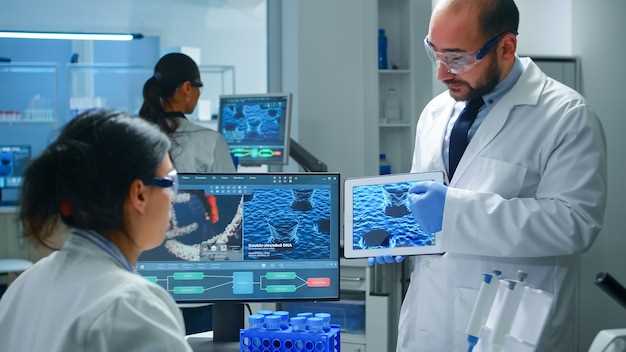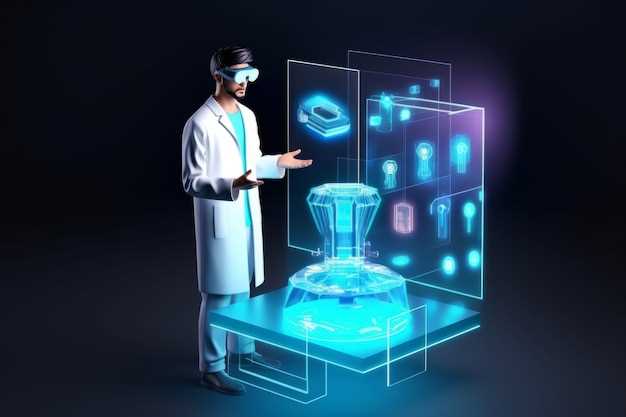
In the ever-evolving landscape of healthcare, constant innovation and groundbreaking advancements are revolutionizing the way we approach medical treatments and patient care. With each passing day, researchers, scientists, and medical professionals are pushing the boundaries of what was once thought impossible, harnessing the power of technology and embracing novel treatment modalities to improve the lives of patients worldwide.
From state-of-the-art diagnostic tools to futuristic surgical techniques, the field of medical technology has witnessed an unprecedented surge in recent years. These advancements have not only enhanced the accuracy and efficiency of diagnoses but have also paved the way for personalized treatment plans tailored to individual patients. With the advent of artificial intelligence and machine learning, medical professionals can now analyze vast amounts of data to identify patterns, predict outcomes, and provide targeted interventions, ultimately leading to better patient outcomes.
Moreover, the integration of robotics and automation has revolutionized surgical procedures, enabling surgeons to perform complex operations with unparalleled precision and minimal invasiveness. Robotic-assisted surgeries have proven to be game-changers in various specialties, allowing for smaller incisions, reduced blood loss, and faster recovery times. Additionally, the use of virtual reality and augmented reality technologies has transformed medical training, providing healthcare professionals with immersive and realistic simulations to enhance their skills and expertise.
While technology plays a pivotal role in healthcare advancements, it is equally important to acknowledge the significant progress made in treatment modalities. Traditional approaches are being reimagined, and alternative therapies are gaining recognition for their potential to complement conventional treatments. From gene therapy and regenerative medicine to targeted immunotherapies, these innovative treatment modalities hold promise in tackling previously untreatable diseases and improving patient outcomes.
As we delve into the realm of healthcare innovations, it becomes evident that the future of medicine is characterized by a harmonious blend of cutting-edge technologies and groundbreaking treatment modalities. By embracing these advancements, we can unlock new possibilities, redefine the boundaries of healthcare, and ultimately provide patients with a brighter and healthier future.
Revolutionizing Diagnostics: Breakthroughs in Medical Imaging
In the realm of medical diagnostics, a remarkable transformation is underway. Cutting-edge advancements in the field of medical imaging are revolutionizing the way healthcare professionals detect and diagnose various conditions. These breakthroughs are reshaping the landscape of diagnostics, offering new possibilities for early detection, accurate diagnoses, and personalized treatment plans.
Medical imaging technologies have undergone significant advancements, enabling healthcare providers to visualize the human body in unprecedented detail. These innovations utilize state-of-the-art imaging modalities, such as magnetic resonance imaging (MRI), computed tomography (CT), ultrasound, and positron emission tomography (PET). Each modality offers unique insights into different aspects of the body, allowing for a comprehensive evaluation of various diseases and conditions.
One of the key benefits of these breakthroughs is the ability to detect diseases at their earliest stages, even before symptoms manifest. Early detection plays a crucial role in improving patient outcomes, as it allows for timely intervention and treatment. Medical imaging techniques can identify subtle changes in the body’s structure and function, enabling healthcare professionals to identify potential abnormalities and initiate appropriate interventions promptly.
Moreover, these advancements in medical imaging have enhanced the accuracy and precision of diagnoses. By providing detailed and high-resolution images, healthcare providers can make more informed decisions regarding patient care. The ability to visualize internal structures and organs in real-time allows for a more accurate assessment of disease progression, facilitating the development of tailored treatment plans that address the specific needs of each patient.
Furthermore, the integration of artificial intelligence (AI) in medical imaging has further propelled the field forward. AI algorithms can analyze vast amounts of imaging data, assisting healthcare professionals in detecting patterns, identifying anomalies, and predicting disease outcomes. This collaboration between human expertise and AI capabilities has the potential to significantly improve diagnostic accuracy and streamline the diagnostic process.
In conclusion, the advancements in medical imaging are revolutionizing diagnostics, offering unprecedented capabilities for early detection, accurate diagnoses, and personalized treatment plans. These breakthroughs empower healthcare professionals to provide more effective and targeted care, ultimately improving patient outcomes and transforming the landscape of healthcare.
Precision Medicine: Personalized Treatment Approaches for Enhanced Patient Outcomes
In the realm of modern healthcare, there is a growing emphasis on precision medicine, which aims to tailor medical treatments and interventions to individual patients based on their unique genetic makeup, lifestyle factors, and environmental influences. This approach recognizes that each patient is distinct and requires personalized care to achieve optimal health outcomes.
Precision medicine encompasses a range of innovative techniques and technologies that enable healthcare professionals to analyze an individual’s genetic information, biomarkers, and other relevant data to develop targeted treatment plans. By leveraging advanced diagnostic tools and sophisticated algorithms, medical practitioners can identify specific genetic mutations or variations that may contribute to the development of diseases or influence an individual’s response to certain medications.
One of the key advantages of precision medicine is its ability to move beyond a one-size-fits-all approach to healthcare. Instead of relying on generalized treatment protocols, precision medicine allows healthcare providers to tailor interventions to the specific needs of each patient. This personalized approach can lead to more effective treatments, reduced adverse reactions, and improved patient outcomes.
Furthermore, precision medicine holds great promise in the field of oncology. By analyzing a patient’s tumor at a molecular level, oncologists can identify specific genetic alterations that drive the growth and spread of cancer. Armed with this knowledge, they can select targeted therapies that directly attack these genetic abnormalities, increasing the chances of successful treatment and minimizing the side effects associated with traditional chemotherapy or radiation.
| Benefits of Precision Medicine: |
|---|
| 1. Personalized treatment plans tailored to individual patients |
| 2. Improved efficacy of treatments |
| 3. Reduced adverse reactions and side effects |
| 4. Enhanced understanding of disease mechanisms |
| 5. Increased patient satisfaction and engagement |
In conclusion, precision medicine represents a paradigm shift in healthcare, offering personalized treatment approaches that consider the unique characteristics of each patient. By harnessing the power of advanced technologies and genetic insights, precision medicine has the potential to revolutionize medical practice and improve patient outcomes across various disease areas.
Robotics in Surgery: Enhancing Precision and Minimizing Invasive Procedures
In the field of surgical procedures, the integration of robotics has revolutionized the way surgeries are performed. This innovative technology has paved the way for enhanced precision and accuracy, while also minimizing the invasiveness of procedures. By utilizing robotic systems, surgeons are able to perform complex surgeries with greater control and dexterity, resulting in improved patient outcomes and reduced recovery times.
Robotic surgery involves the use of specialized robotic systems that are controlled by highly skilled surgeons. These systems consist of robotic arms equipped with surgical instruments and a high-definition camera. The surgeon operates the robotic arms from a console, which provides a magnified, 3D view of the surgical site. This allows for precise movements and a greater range of motion, enabling surgeons to navigate through delicate tissues and perform intricate procedures with minimal disruption.
One of the key advantages of robotics in surgery is the ability to perform minimally invasive procedures. Traditional open surgeries often require large incisions, resulting in significant trauma to the patient’s body. In contrast, robotic surgery utilizes small incisions, through which the robotic arms and instruments are inserted. This minimizes the trauma to surrounding tissues, reduces the risk of infection, and leads to faster recovery times for patients.
Furthermore, robotics in surgery offers improved precision and accuracy. The robotic systems are designed to eliminate hand tremors and provide a steady and stable platform for surgeons. This allows for precise movements, even in the most intricate procedures. Additionally, the robotic arms can be programmed to filter out any sudden movements, further enhancing the precision and reducing the risk of accidental damage to surrounding tissues.
Robotic surgery has been successfully utilized in various surgical specialties, including urology, gynecology, cardiothoracic surgery, and orthopedics. It has enabled surgeons to perform complex procedures such as prostatectomies, hysterectomies, coronary artery bypass grafting, and joint replacements with improved outcomes and reduced complications.
| Benefits of Robotics in Surgery: |
|---|
| Enhanced precision and accuracy |
| Minimized invasiveness of procedures |
| Reduced trauma to surrounding tissues |
| Faster recovery times |
| Improved outcomes and reduced complications |
Telemedicine: Bridging the Gap in Access to Healthcare Services

In today’s rapidly evolving world, the field of healthcare is constantly being transformed by innovative solutions. One such solution that is revolutionizing the way healthcare services are delivered is telemedicine. Telemedicine is a cutting-edge technology that bridges the gap in access to healthcare services, bringing medical expertise and treatment to patients regardless of their geographical location.
Enhancing Accessibility and Convenience

Telemedicine eliminates the barriers of distance and time, allowing patients to receive medical consultations and treatment remotely. Through the use of video conferencing and other communication technologies, patients can connect with healthcare professionals from the comfort of their own homes. This not only saves time and money but also provides convenience for individuals who may have difficulty traveling to a healthcare facility.
Improving Healthcare in Underserved Areas
One of the significant advantages of telemedicine is its ability to improve healthcare access in underserved areas. Remote and rural communities often face challenges in accessing quality healthcare services due to limited resources and a shortage of healthcare professionals. Telemedicine enables these communities to overcome these barriers by connecting them with specialists and experts who can provide remote consultations, diagnosis, and treatment. This ensures that individuals in underserved areas receive the same level of care as those in urban areas.
| Benefits of Telemedicine: |
|---|
| 1. Increased access to healthcare services |
| 2. Cost-effective for patients |
| 3. Reduced travel time and expenses |
| 4. Improved healthcare outcomes |
| 5. Enhanced collaboration between healthcare professionals |
Telemedicine is transforming the healthcare landscape, making quality healthcare more accessible and convenient for individuals worldwide. By bridging the gap in access to healthcare services, telemedicine is revolutionizing the way healthcare is delivered, ensuring that everyone has the opportunity to receive the care they need, regardless of their location.
Artificial Intelligence in Healthcare: Transforming Data Analysis and Decision-Making
Revolutionary advancements in the field of healthcare are being driven by the integration of artificial intelligence (AI) into various aspects of medical practice. AI is transforming the way data is analyzed and decisions are made, leading to improved patient outcomes and more efficient healthcare delivery.
AI algorithms have the ability to process vast amounts of medical data, including patient records, medical images, and research findings, at a speed and accuracy that surpasses human capabilities. By utilizing machine learning techniques, AI systems can identify patterns and trends within this data, enabling healthcare professionals to make more informed decisions and develop personalized treatment plans.
One of the key areas where AI is making a significant impact is in diagnostic imaging. AI-powered algorithms can analyze medical images, such as X-rays, MRIs, and CT scans, to detect abnormalities and assist radiologists in making accurate diagnoses. This not only reduces the time taken to interpret images but also enhances the accuracy of diagnoses, leading to earlier detection of diseases and improved patient outcomes.
Furthermore, AI is also being utilized in predictive analytics, where it can analyze patient data to identify individuals who are at a higher risk of developing certain conditions. By identifying these high-risk patients, healthcare providers can intervene earlier and implement preventive measures, ultimately reducing the burden on the healthcare system and improving population health.
In addition to data analysis, AI is also transforming decision-making processes in healthcare. AI-powered systems can provide healthcare professionals with evidence-based recommendations and treatment guidelines, helping them make more informed decisions about patient care. This not only improves the quality of care but also reduces the potential for errors and variability in treatment outcomes.
Overall, the integration of artificial intelligence in healthcare is revolutionizing data analysis and decision-making processes. By harnessing the power of AI, healthcare professionals can leverage vast amounts of medical data to improve patient outcomes, enhance diagnostic accuracy, and optimize treatment plans. As AI continues to evolve, its potential to transform healthcare delivery and improve patient care is limitless.
Gene Editing: Promising Advances in Genetic Therapies and Disease Prevention
In the realm of genetic therapies and disease prevention, gene editing has emerged as a groundbreaking field with immense potential. This innovative approach allows scientists to make precise changes to an individual’s DNA, offering new possibilities for treating genetic disorders and preventing the onset of diseases. By manipulating genes, researchers can target specific mutations or introduce beneficial modifications, paving the way for personalized medicine and improved healthcare outcomes.
Unlocking the Potential of CRISPR
One of the most promising gene editing techniques is CRISPR-Cas9, a revolutionary tool that has revolutionized the field. CRISPR, short for Clustered Regularly Interspaced Short Palindromic Repeats, is a naturally occurring system found in bacteria that can be harnessed to edit genes. Cas9, an enzyme, acts as a pair of molecular scissors, cutting the DNA at a specific location. This breakthrough technology enables scientists to modify genes with unprecedented precision, offering hope for treating a wide range of genetic disorders.
Applications in Disease Prevention and Treatment
The potential applications of gene editing in disease prevention and treatment are vast. By correcting genetic mutations, researchers aim to eliminate the root causes of various inherited diseases, such as cystic fibrosis, sickle cell anemia, and muscular dystrophy. Additionally, gene editing holds promise in preventing the transmission of genetic disorders from parents to their children, offering hope for future generations. Furthermore, this technology can be utilized to enhance the effectiveness of existing treatments, such as cancer therapies, by making cancer cells more susceptible to targeted drugs.
Gene editing also opens up possibilities for creating genetically modified organisms (GMOs) that can address pressing global challenges. For instance, scientists are exploring the use of gene editing to develop crops that are resistant to pests, diseases, and adverse environmental conditions, thereby increasing agricultural productivity and ensuring food security.
While the potential of gene editing is immense, ethical considerations and regulatory frameworks must be carefully addressed to ensure responsible and equitable use of this technology. As research progresses, it is crucial to strike a balance between scientific advancements and ethical boundaries, ensuring that gene editing is used for the greater benefit of humanity.
In conclusion, gene editing represents a promising advancement in genetic therapies and disease prevention. With the power to modify genes with precision, this innovative technology offers hope for treating genetic disorders, preventing diseases, and addressing global challenges. As scientists continue to explore the potential of gene editing, it is essential to navigate the ethical and regulatory landscape to ensure its responsible and equitable use.






